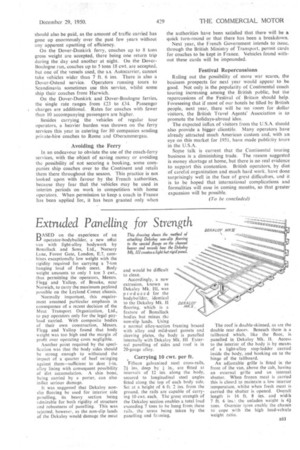Extruded Panelling for Strength B ASED on the experience of an
Page 45

If you've noticed an error in this article please click here to report it so we can fix it.
operator-bodybuilder, a new inbat van with light-alloy bodywork by Banallack and Sons, Ltd., Nursery Lane, Forest Gate, London, E.7, combines exceptionally low weight with the rigidity required fot carrying a 7-ton hanging toad of fresh meat. Body weight amounts to only I ton 3 cwt., thus permitting the operators, Messrs. Flegg and Yallop, of Brooke, near Norwich, to carry the maximum payload possible On the Leyland Comet chassis.
Normally important, this requirement assumed particular emphasis in consequence of a recent decision of the Meat Transport Organization, Ltd., to pay operators only for the legal payload carried. With composite bodies of their own construction, Messrs. "Hen and Yallop found that body weight was too high and the margin of profit over operating costs negligible.
Another point required by the specification was that the body sides should be strong enough to withstand the impact of a quarter of beef swinging against them—sufficient to dent 1-in. alloy lining with consequent possibility of dirt accumulation. A shin bone, being carried by a porter, can also
inflict serious damage.
It was suggested that Dekaloy nonslip flooring be used for interior side panelling, its heavy section being [,dmirable for both rigidity of structure and robustness of panelling. This was rejected, however, as the non-slip lands of the Dekaloy would damage the meat
and would be difficult to clean.
Accordingly, a new extrusion, known as Dekaloy Mk. III, was produced for the bodybuilder, identical to the Dekaloy Mk. 11 flooring, which is a feature of BonaHack bodies but minus tha., non-slip lands. Using a normal alloy-section framing braced with alloy and mild-steel gussets and sleeving plates, the body is panelled internally with Dekaloy Mk, Ill External panelling of sides and roof is in 20-gauge alloy.
DI K A WY MK If
Carrying 10 cwt. per ft. *Fifteen galvanized steel cross-rails,
21 ins, deep by in., are fitted at intervals of 12 ins, along the body, secured to longitudinal steel angles fitted along the top of each body side. Set at a height of 6 ft. 2 ins, from the ground, the rails are capable of carrying 10 cwt. each. The great strength of the Dekaloy section enables a total load exceeding 7 tons to be hung from, these rails, the stress being taken by the panelling and framing.
The roof is double-skinned, as are the double rear doors. Beneath them is a tailboard which, like the floor, is panelled in Dekaloy Mk. 11. Access to the interior of the body is by means of a light-alloy step-ladder carried inside the body, and hooking on to the hinge of the tailboard.
An adjustable grille is fitted in the front of the van, above the cab, having an external grille and an internal shutter. When frozen meat is carried this is closed to maintain a low interior temperature. whilst when fresh meat is carried the shutter is opened. Overall length is 16 ft. 8 ins and width 7 ft. 6 ins.: the unladen weight is 4i tons. Oversize tyres enable the chassis to cope with the high load-vehicle weight ratio.




















































































